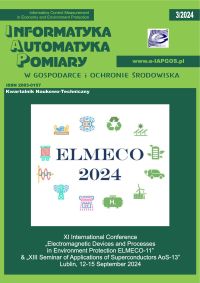WYKORZYSTANIE NARZĘDZI WEB 2.0 PRZEZ POLSKIE PORTALE POŚWIĘCONE ZDROWIU
Magdalena Czerwinska
m.czerwinska@pollub.plPolitechnika Lubelska, Wydział Zarządzania (Polska)
http://orcid.org/0000-0002-7945-1044
Abstrakt
Internet, jako globalna, uniwersalna sieć komunikacyjna, stał się ważnym kanałem dystrybucji informacji. Obecnie ma bardzo społeczny charakter, dzięki upowszechnieniu serwisów Web 2.0, które umożliwiają użytkownikom tworzenie i publikowanie własnych treści multimedialnych. Technologie Web 2.0 ułatwiają użytkownikom komunikację, tworzenie, współpracę i udostępnianie informacji. Są powszechnie dostępne i charakteryzują się niskimi kosztami użytkowania. W artykule przedstawiono wyniki badań najpopularniejszych polskich serwisów poświęconych zdrowiu. Zbadano, czy usługi zdrowotne spełniają wymagania witryn Web 2.0. Analiza koncentruje się na aspektach technologicznych i społecznych. Zaobserwowano, że zamknięcie gospodarki wskutek pandemii COVID-19 w marcu i kwietniu 2020 r. w Polsce znacząco wpłynęło na użytkowników i oglądalność witryn o tematyce zdrowotnej. Uzyskane wyniki potwierdzają wykorzystanie wybranych do badań elementów (zarówno technologicznych, jak i społecznych). Jednak wykorzystanie technologii Web 2.0 na poszczególnych witrynach internetowych jest zróżnicowane.
Słowa kluczowe:
informacja zdrowotna, strony internetowe poświęcone zdrowiu, Web 2.0, Health 2.0Bibliografia
Bos L, Marsh A, Carroll D, Gupta S, Rees M.: Patient 2.0 Empowerment. SWWS 97(4), 2008, 164–168.
Google Scholar
Czerwinska M.: Specificity of the e-patients’ behaviours on the Internet. Collegium of Economic Analysis Annals 38, 2015, 343–352.
Google Scholar
Czerwinska M.: The Influence of the Digitalisation of Health-Related Information on Internauts’ Behaviour. Collegium of Economic Analysis Annals 46, 2017, 39–49.
Google Scholar
Davison K. P., Pennebaker J. W.: Virtual narratives: Illness representations in online support groups. Petrie K. J., Weinman J. A. (Ed.): Perceptions of health and illness: Current research and applications. Harwood Academic Publishers. Amsterdam 1997.
Google Scholar
Gümüş H., Bal V.: Analysis of the Effect of Quality Components of Web 2.0 Enabled E-Commerce Websites on Electronic Word-of-Mouth Marketing (EWOM) and on Customer Loyalty. Annals of the University of Oradea – Economic Science 25(1), 2016, 979–986.
Google Scholar
Identify technologies on websites, https://www.wappalyzer.com/ (accessed: 11.10.2020).
Google Scholar
Information society in Poland. How do we use the Internet? 2019. https://stat.gov.pl, (available: October 2020).
Google Scholar
Information society in Poland. Results of statistical surveys in the years 2015–2019. https://stat.gov.pl (available: 12. 2019).
Google Scholar
Júnior S. H. D. L., Silva F. Í. C., Albuquerque G. S. G., de Medeiros, F. P. A., Lira H. B.: Enterprise Architecture in Healthcare Systems: A systematic literature review. 2020 arXiv preprint arXiv:2007.06767.
Google Scholar
Kotsenas A. L., Arce M., Aase L., Timimi F. K., Young C., Wald, J. T.: The strategic imperative for the use of social media in health care. Journal of the American College of Radiology 15(1), 2018, 155–161.
DOI: https://doi.org/10.1016/j.jacr.2017.09.027
Google Scholar
Krouska A., Troussas C., Virvou M.: A literature review of Social Networking-based Learning Systems using a novel ISO-based framework. Intelligent Decision Technologies 13(1), 2019, 23–39.
DOI: https://doi.org/10.3233/IDT-190362
Google Scholar
Laurenza E., Quintano M., Schiavone F., Vrontis, D.: The effect of digital technologies adoption in healthcare industry: a case based analysis. Business Process Management Journal 24(5), 2018, 1124–1144.
DOI: https://doi.org/10.1108/BPMJ-04-2017-0084
Google Scholar
Maheshwari B., Sarrion M., Motiani, M., O’Sullivan, S., Chandwani, R.: Exploration of factors affecting the use of Web 2.0 for knowledge sharing among healthcare professionals: an Indian perspective. Journal of Knowledge Management, 2020 [https://doi.org/10.1108/JKM-02-2020-0105].
DOI: https://doi.org/10.1108/JKM-02-2020-0105
Google Scholar
Musto C., Semeraro G., de Gemmis M., Lops P.: Learning word embeddings from wikipedia for content-based recommender systems. European Conference on Information Retrieval. Springer, Cham. 2016.
DOI: https://doi.org/10.1007/978-3-319-30671-1_60
Google Scholar
Research Gemius/PBI company. Report: Internet health websites (in Polish), http://pbi.org.pl (accessed: 11.10.2020).
Google Scholar
Van der Belt T.H., Engelen L.J., Berben S.A., Schoonhoven L.: Definition of Health 2.0 and Medicine 2.0: A Systematic Review. Journal of Medical Internet Research 12(2), 2010, e18 [http://doi.org/10.2196/jmir.1350].
DOI: https://doi.org/10.2196/jmir.1350
Google Scholar
Van der Vaart R., Drossaert C.: Development of the Digital Health Literacy Instrument: Measuring a Broad Spectrum of Health 1.0 and Health 2.0 Skills. Journal of Medical Internet Research 19(1), 2017, e27 [http://doi.org/10.2196/jmir.6709].
DOI: https://doi.org/10.2196/jmir.6709
Google Scholar
We are social, Global Digital Report 2020, https://wearesocial.com/digital-2020, (2020).
Google Scholar
Web 2.0: https://en.wikipedia.org/wiki/Web_2.0 (accessed: 10.2020).
Google Scholar
Yusif S., Hafeez-Baig A., Soar J.: e-Health readiness assessment factors and measuring tools: A systematic review. International Journal of Medical Informatics 107, 2017, 56–64.
DOI: https://doi.org/10.1016/j.ijmedinf.2017.08.006
Google Scholar
Autorzy
Magdalena Czerwinskam.czerwinska@pollub.pl
Politechnika Lubelska, Wydział Zarządzania Polska
http://orcid.org/0000-0002-7945-1044
Statystyki
Abstract views: 407PDF downloads: 293
Licencja

Utwór dostępny jest na licencji Creative Commons Uznanie autorstwa – Na tych samych warunkach 4.0 Miedzynarodowe.








